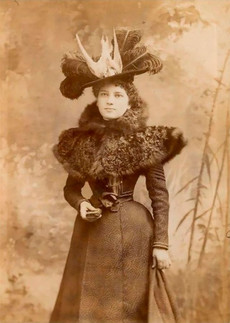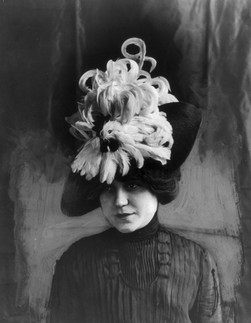The Cat on the Hat at the Party of the Century
- Cat Dorman
- May 9, 2022
- 4 min read
On March 26, 1883, Alva Vanderbilt hosted her first costume ball in New York City, determined to set herself as one of society’s leading ladies. Relatively new to the New York scene at this time, the (relatively) new money Vanderbilts had not yet been embraced by queen bee Caroline Astor, but this party changed everything. In order to secure an invitation for her daughter, to what was set to be the party of the year, Caroline finally had to call on Alva and effectively welcome her into the upper echelon. And she’s likely glad she did because the costume party was as spectacular as anyone could have hoped, later to be called not only the party of the season, but the party of the century, costing an estimated $250,000 (which is roughly a cool $6 million in today’s money).

Alva Vanderbilt’s grand ball and set a tone for the opulent parties that would follow her model over the coming decades in New York, ushering in an era of new money gilt and glamor as opposed to the Astor’s old money sensibilities. The event was the pinnacle of who’s who in New York society, its invitees principally made up of an actual list of the most important people in New York’s social scene, known as The 400. They came dressed to the 10’s in costumes including Marie Antoinette, the Four Seasons, Night, Day, Innocence, the Electric Light and the Count of Monte Cristo. Into this crowd of allegory and history strode Miss Kate Fearing Strong with a taxidermy cat stuck on her head, nine white, fluffy cat tails hanging from her skirt and a diamond choker that read “PUSS.” Her look, rather than taking inspiration from cultural touchpoints, was inspired by her own nickname… you guessed it “Puss.” It’s pretty badass to show up to THE event of the year in a costume inspired by yourself.

We couldn’t find much about Kate and her family, except that her parents were also socialites in New York and friends of author Henry James. Through his letters we are able to glean a bit more about Puss’s personality. At the time of the ball Kate was married to Mr. Arthur Welman, but was still referred to by her maiden name in most accounts. Whether this is because she was a woman with a strong sense of her own identity, or because her husband was fairly unpopular, with James referring to him as “useless” in his letters, or because her family’s name carried more weight, we can’t be sure. We do know, though, that James referred to Kate “youthful and precocious.” This seems in line with the bold and fearless figure she cuts with her costume of cat parts.
Kate likely wasn’t alone in wearing some form of taxidermy to the event. In the late Victorian period feathers and then taxidermy birds became fashionable accessories for upper and middle class women. The more wealthy you were, the more extravagant the bird on your head would be. The late 19th Century taste for taxidermy differs from our own. Just as it wasn’t uncommon for milliners to attach taxidermy birds to women’s hats, it was also at this time that Walter Potter was making his now iconic kitten dioramas which captivated audiences with their macabre kitsch. But a cat on the head was certainly a sight to behold.

Usually, the birds one might find at the local haberdashery were exotic and splendid, a far cry from the pigeon perched on the corner. The hats signified both the owner’s social and financial status as they were able to keep up with the seasons latest trends, as well as our eternal desire to demonstrate man’s dominance over nature. Cats, however, were not shipped over from halfway across the globe as a show of exotic opulence, they could be found milling around the street corners of New York. The cat on Kate’s head was a beautiful pure white, perhaps symbolizing purity or virtue, so it likely wasn’t just scooped up from the street corner, but it also probably didn’t come from Colonial conquest.
Kate’s taxidermy outfit wouldn’t have shocked the other partygoers like it would today had she worn it to the Met Gala, but the use of a domestic cat likely gave something of a wow factor. Cats were very much house pets in this era, and it was around this time that organizations dedicated to their pedigree were founded in the US and UK. It’s likely that partygoers, if not Kate herself, had cats waiting for them at home. Because of their intimacy in the home, Kate’s cat hat is more unsettling than an exotic bird that would never otherwise be seen in daily life. She likely wore the hat to be sensational and make an impact in a room full of people trying to stand out.

[Left to Right: Mrs. William Seward Webb (neé Lila O. Vanderbilt), dressed as a hornet and wearing a headdress of diamonds, Cornelius and Alice Gwynne Vanderbilt II as Louis XVI and the Electric Light & Miss Henrietta Strong, looking like a living porcelain doll.]
And she succeeded. The New York Times report on the party the next day catalogued how guests partied well into the early hours of the morning and featured some of the most memorable outfits of the night. Kate was, of course, among those named. Her notoriety was further solidified by Alva Vanderbilt’s having hired one of the top society photographers of the day, Jose Maria Mora, to take portraits of all of the guests, and it is this image that has spread knowledge of the Puss costume far beyond New York society. In it Kate’s wistful gaze and delicate pose are rendered absurd by the dead-eyed, misshapen cat atop her head as “Puss” glitters from her neck. She proves that in a room full of spectacle and people trying to be someone, sometimes it’s most effective to be your weird and wonderful self.











留言